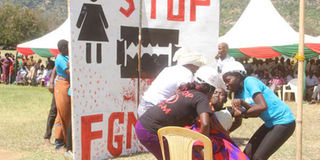One in five women of reproductive age have undergone the cut

Students from various universities stage a play against female circumcision. The presentation took place at the Kerio Valley Boys Secondary School in Tot, Elgeyo-Marakwet County, on February 7, 2016 during an event to mark the International Day of Zero Tolerance to Female Genital Mutilation. PHOTO | JARED NYATAYA | NATION MEDIA GROUP
What you need to know:
Surveys shows that 21 per cent of Kenyan women aged between 15 and 49 underwent circumcision in 2014
One in four women have undergone circumcision is “one too many”.
Fighting female circumcision is difficult because it is a deep-rooted cultural practice that has transformed with the times.
Amref has helped 1,400 girls graduate in its alternative rites of passage programme.
A crackdown on female circumcision is facing setbacks even as statistics point towards a decline in the practice in recent years, agencies fighting the vice said Sunday.
A review of country-specific demographic and health surveys shows that 21 per cent of Kenyan women aged between 15 and 49 underwent circumcision in 2014. This was a marked reduction from 27 per cent in 2009 and 38 per cent in 2003.
Amref Health Africa CEO Githinji Gitahi attributed the reduction partly to the coming into place of a law against the practice, awareness campaigns and alternative ceremonies.
He, however, said the situation where one in four women have undergone circumcision is “one too many”.
“To quote the First Lady, we have to eradicate it beyond zero,” said Dr Gitahi.
Worth noting are remarks by various speakers at an inter-agency meeting that the methods used had mutated from the usual open cultural ceremonies to covert ones, adopted to protect individuals perpetrating the practice from the police.
The meeting was held ahead of the International Day of Zero Tolerance to Female Genital Mutilation (FGM) on Saturday.
An event to mark the day in Nairobi was organised by Amref Health Africa.
CULTURAL PRACTICE
Ms Njilisen Lengupae, a former traditional circumciser from Maralal who is now out to rescue girls, says the Samburu community is still lagging behind in the fight against the practice.
She said fighting female circumcision is difficult because it is a deep-rooted cultural practice that has transformed with the times.
Ms Lengupae said it is still prevalent but being done underground since its criminalisation.
“Nowadays, women circumcise their daughters as they circumcise their sons. Some even take their daughters to homes where boys are being circumcised to keep law enforcers from sniffing them out,” she reveals.
She added: “For most women, carrying it out is a source of income. I earned Sh1,000 circumcising one girl. I would handle 100 girls in a busy month such as December and earn Sh100,000. No wonder it is important that the circumcisers are given an alternative source of income. Otherwise they will continue to rally their communities to observe the practice.”
It was also noted that in Kisii the practice had been “medicalised”.
“More and more parents try to minimise the immediate health effects of the practice and hide by having their daughters circumcised by health providers,” said Healthcare Assistance Kenya’s Harriet Msianeli.
ALTERNATIVE PRACTICES
Although alternative rites of passage have helped to mitigate female circumcision, there are still some defiant forces.
Ms Beverly Tanui from Magadi went through the alternative rites in 2014.
She said: “There were many girls in our group who graduated. Unfortunately, about 20 per cent of the members have not continued with their education because their parents secretly took them for the ‘cut’. In addition, they were married off.”
She said she was lucky that her parents were more understanding and have supported her decision not to undergo circumcision and her resolve to remain in school.
Amref has helped 1,400 girls graduate in its alternative rites of passage programme. About 8,000 were from Kajiado and 600 from Samburu. At least 200 more girls are set to graduate.
“We are impressed by the successes and are getting invited to more parts of the country where the practice is deep-rooted, but we still have major challenges. I have seen some communities subjecting very young girls, who are yet to reach the circumcision age, to avoid detection,” said Dr Gitahi.




